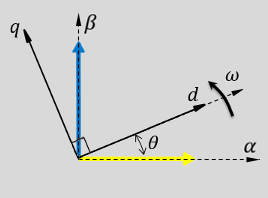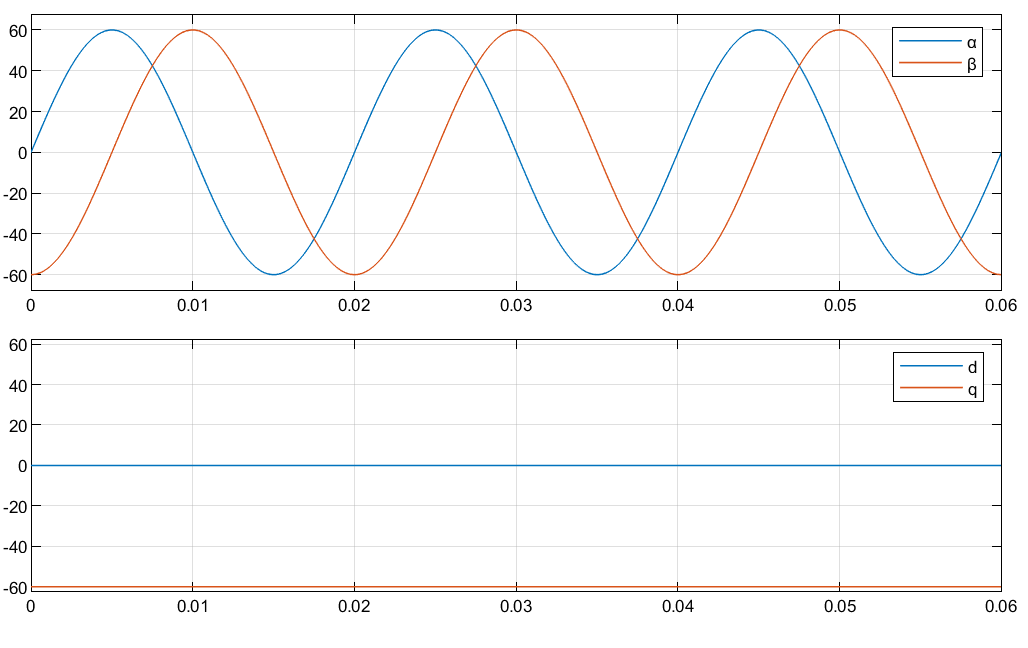Park Transform
αβ から dq への変換の実装
ライブラリ:
Motor Control Blockset /
Controls /
Math Transforms
Motor Control Blockset HDL Support /
Controls /
Math Transforms
説明
Park Transform ブロックは、静止 αβ 基準座標系における二相直交成分 (α、β) または多重化された αβ0 成分の Park 変換を計算します。
このブロックは次の入力を受け取ります。
静止基準座標系における α-β 軸成分または多重化された成分 αβ0。[入力数] パラメーターを使用して 2 つまたは 3 つの入力を使用します。
変換の対応する角度の正弦値と余弦値。
2 入力構成を使用する場合、回転 dq 基準座標系における直交直 (d) 軸成分および横 (q) 軸成分を出力します。3 入力構成を使用する場合、多重化された成分 dq0 を出力します。
平衡システムの場合、ゼロ成分はゼロに等しくなります。
このブロックでは、d 軸または q 軸を時間 t = 0 において α 軸に揃えるように構成できます。
次の図は、以下の場合の αβ 基準座標系と回転 dq 基準座標系における α-β 軸成分を示しています。
d 軸が α 軸と揃っている。

q 軸が α 軸と揃っている。

どちらの場合も、角度は θ = ωt です。
θ は、d 軸に揃える場合は α 軸と d 軸の間の角度、q 軸に揃える場合は α 軸と q 軸の間の角度です。α 軸に対する回転 dq 基準座標系の角度位置を示します。
ω は、d-q 基準座標系の回転速度です。
t は、最初の配置からの時間 (秒数) です。
次の図は、以下の場合の αβ 基準座標系と dq 基準座標系の各成分の時間応答を示しています。
d 軸が α 軸と揃っている。

q 軸が α 軸と揃っている。

方程式
[入力数] パラメーターが [2 つの入力] に設定されている場合、ブロックによる Park 変換の実装方法は次の方程式で記述されます。
d 軸が α 軸と揃っている場合。
q 軸が α 軸と揃っている場合。
ここで、
と は、静止 αβ 基準座標系における二相直交成分です。
と は、回転 dq 基準座標系における直軸および横軸直交成分です。
[入力数] パラメーターが [3 つの入力] に設定されている場合、ブロックによる Park 変換の実装方法は次の方程式で記述されます。
Clarke to Park Angle Transform ブロックは、a 相から q 軸の配置の変換を次のように実装します。
ここで、
α と β は、静止基準座標系における二相システムの alpha 軸成分と beta 軸成分です。
0 はゼロ成分です。
d と q は、回転基準座標系における 2 軸システムの直軸成分と横軸成分です。
a 相から d 軸の配置の場合、ブロックは次の方程式を使用して変換を実装します。
例
端子
入力
出力
パラメーター
拡張機能
バージョン履歴
R2020a で導入


